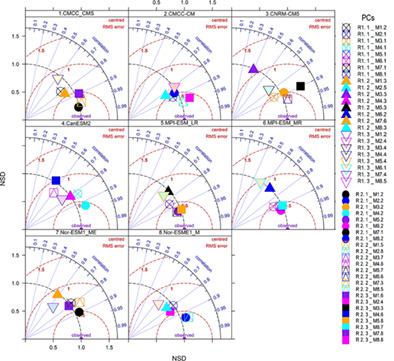当前位置:
X-MOL 学术
›
Int. J. Climatol.
›
论文详情
Our official English website, www.x-mol.net, welcomes your feedback! (Note: you will need to create a separate account there.)
Precipitation projections over the Indus River Basin of Pakistan for the 21st century using a statistical downscaling framework
International Journal of Climatology ( IF 3.9 ) Pub Date : 2021-06-06 , DOI: 10.1002/joc.7244 Muhammad Saleem Pomee 1, 2 , Elke Hertig 1, 2
International Journal of Climatology ( IF 3.9 ) Pub Date : 2021-06-06 , DOI: 10.1002/joc.7244 Muhammad Saleem Pomee 1, 2 , Elke Hertig 1, 2
Affiliation

|
We estimate future changes in precipitation over the entire Indus basin of Pakistan with a particular focus on the high-elevation upper indus basin (UIB). A statistical downscaling approach is used. We consider the spatial variability of observed precipitation on seasonal scales. Large-scale atmospheric patterns are employed for general circulation model (GCM) selection and subsequent projections. Firstly, we identify the precipitation governing predictors from ERA-Interim reanalysis. We further quantify the robustness of governing predictors against other reanalysis datasets (ERA5 and NCEP-NCAR-II) to assess future projections' fidelity. We perform S-mode Principal Component Analysis on predictor fields and compare loading patterns using Taylor diagrams to assess predictor correspondence between different reanalysis. Similarly, we compare ERA-Interim variables with model-simulated fields during the historical period to select better performing GCMs and quantify model uncertainty. The regional suitability of available GCMs in our study is also demonstrated. Ensemble (median) changes in regional precipitation derived through atmospheric fields show an elevation-dependent response of the UIB at representative concentration pathway (RCP) scenarios RCP4.5 and RCP8.5, where increased precipitation will mostly fall at high elevations. However, the positive signals are more distinct during the winter and monsoon seasons, particularly over the central Karakoram. Meanwhile, a decrease in precipitation is robust during the pre-monsoon period, particularly over the northwestern regions. These signals intensify and become more robust during 2071–2100 under RCP8.5, and the better-performing models and signal-to-noise ratios further support this finding. The spatial patterns of projected changes suggest stronger (weaker) and further northward penetrating westerly systems during the winter (pre-monsoon) season. Increased warming will also strengthen monsoon circulations, and these will penetrate further into the northwestern and trans-Himalayan regions. The Lower Indus shows a mixed seasonal response that is more uncertain. The present analysis provides an alternative perspective to the ongoing research of assessing climate responses in complex regions.
中文翻译:

使用统计降尺度框架预测巴基斯坦印度河流域 21 世纪的降水量
我们估计了巴基斯坦整个印度河盆地未来降水的变化,特别关注高海拔上印度河盆地 (UIB)。使用统计降尺度方法。我们考虑季节尺度上观测到的降水的空间变异性。大尺度大气模式用于大气环流模式 (GCM) 选择和后续预测。首先,我们从 ERA-Interim 再分析中确定降水控制预测因子。我们进一步量化了治理预测变量对其他再分析数据集(ERA5 和 NCEP-NCAR-II)的稳健性,以评估未来预测的保真度。我们对预测变量字段执行 S 模式主成分分析,并使用泰勒图比较加载模式,以评估不同再分析之间的预测变量对应关系。相似地,我们将 ERA-Interim 变量与历史时期的模型模拟字段进行比较,以选择性能更好的 GCM 并量化模型的不确定性。还证明了我们研究中可用的 GCM 的区域适用性。通过大气场得出的区域降水的集合(中值)变化显示了 UIB 在具有代表性的浓度路径(RCP)情景 RCP4.5 和 RCP8.5 的海拔依赖性响应,其中增加的降水将主要落在高海拔地区。然而,在冬季和季风季节,特别是在喀喇昆仑中部,积极信号更为明显。同时,在季风前期间,降水量明显减少,尤其是在西北部地区。在 RCP8.5 下,这些信号在 2071 年至 2100 年期间增强并变得更加强大,性能更好的模型和信噪比进一步支持了这一发现。预计变化的空间模式表明,在冬季(季风前)季节,西风系统更强(更弱)且进一步向北渗透。变暖的加剧还将加强季风环流,这些环流将进一步渗透到西北部和跨喜马拉雅地区。印度河下游表现出混合的季节性反应,更加不确定。本分析为正在进行的评估复杂地区气候响应的研究提供了另一种视角。变暖的加剧还将加强季风环流,这些环流将进一步渗透到西北部和跨喜马拉雅地区。印度河下游表现出混合的季节性反应,更加不确定。本分析为正在进行的评估复杂地区气候响应的研究提供了另一种视角。变暖的加剧还将加强季风环流,这些环流将进一步渗透到西北部和跨喜马拉雅地区。印度河下游表现出混合的季节性反应,更加不确定。本分析为正在进行的评估复杂地区气候响应的研究提供了另一种视角。
更新日期:2021-06-06
中文翻译:

使用统计降尺度框架预测巴基斯坦印度河流域 21 世纪的降水量
我们估计了巴基斯坦整个印度河盆地未来降水的变化,特别关注高海拔上印度河盆地 (UIB)。使用统计降尺度方法。我们考虑季节尺度上观测到的降水的空间变异性。大尺度大气模式用于大气环流模式 (GCM) 选择和后续预测。首先,我们从 ERA-Interim 再分析中确定降水控制预测因子。我们进一步量化了治理预测变量对其他再分析数据集(ERA5 和 NCEP-NCAR-II)的稳健性,以评估未来预测的保真度。我们对预测变量字段执行 S 模式主成分分析,并使用泰勒图比较加载模式,以评估不同再分析之间的预测变量对应关系。相似地,我们将 ERA-Interim 变量与历史时期的模型模拟字段进行比较,以选择性能更好的 GCM 并量化模型的不确定性。还证明了我们研究中可用的 GCM 的区域适用性。通过大气场得出的区域降水的集合(中值)变化显示了 UIB 在具有代表性的浓度路径(RCP)情景 RCP4.5 和 RCP8.5 的海拔依赖性响应,其中增加的降水将主要落在高海拔地区。然而,在冬季和季风季节,特别是在喀喇昆仑中部,积极信号更为明显。同时,在季风前期间,降水量明显减少,尤其是在西北部地区。在 RCP8.5 下,这些信号在 2071 年至 2100 年期间增强并变得更加强大,性能更好的模型和信噪比进一步支持了这一发现。预计变化的空间模式表明,在冬季(季风前)季节,西风系统更强(更弱)且进一步向北渗透。变暖的加剧还将加强季风环流,这些环流将进一步渗透到西北部和跨喜马拉雅地区。印度河下游表现出混合的季节性反应,更加不确定。本分析为正在进行的评估复杂地区气候响应的研究提供了另一种视角。变暖的加剧还将加强季风环流,这些环流将进一步渗透到西北部和跨喜马拉雅地区。印度河下游表现出混合的季节性反应,更加不确定。本分析为正在进行的评估复杂地区气候响应的研究提供了另一种视角。变暖的加剧还将加强季风环流,这些环流将进一步渗透到西北部和跨喜马拉雅地区。印度河下游表现出混合的季节性反应,更加不确定。本分析为正在进行的评估复杂地区气候响应的研究提供了另一种视角。



























 京公网安备 11010802027423号
京公网安备 11010802027423号